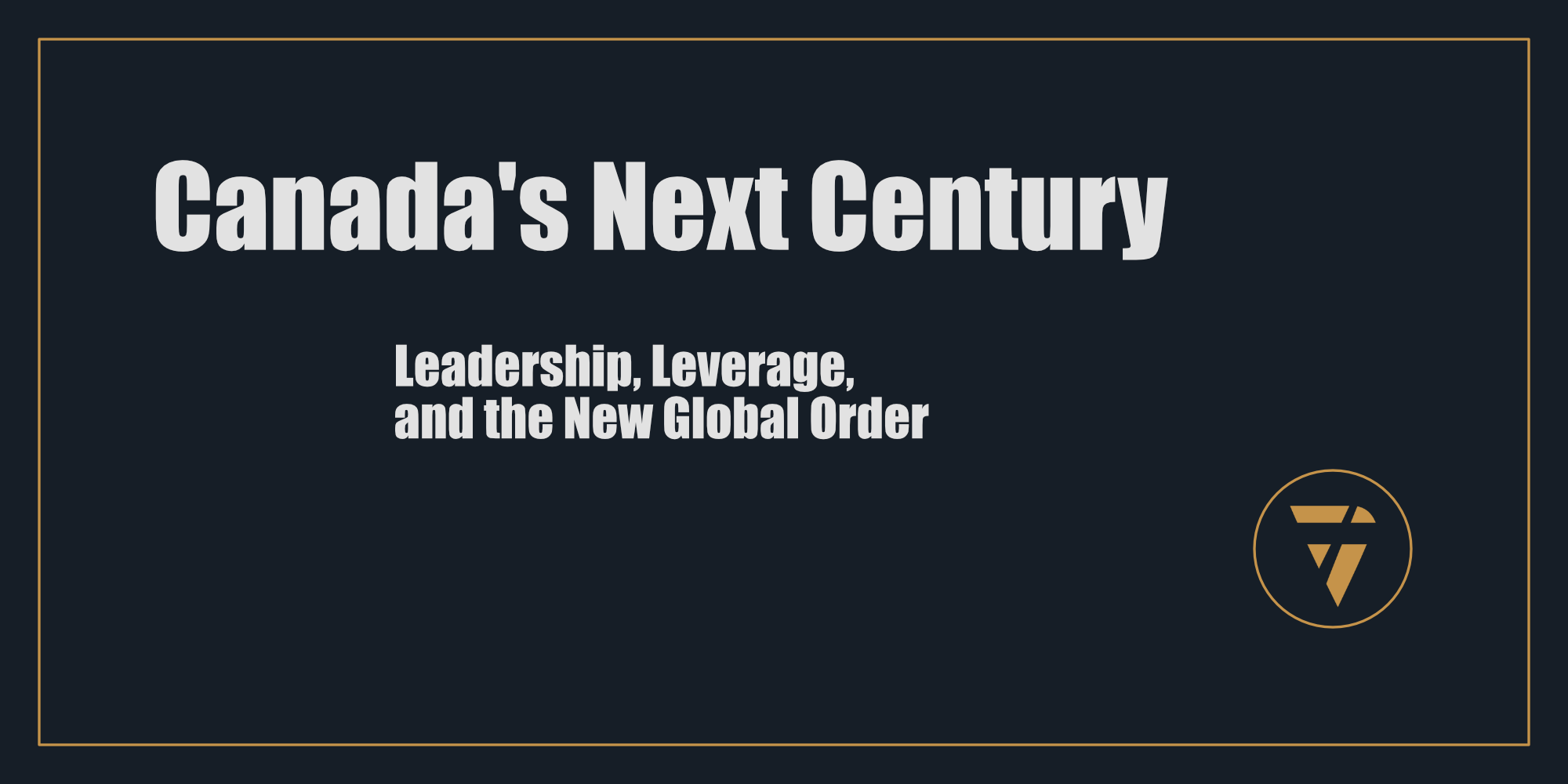Canada’s Next Century

Leadership, Leverage, and the New Global Order
The global economy is fracturing. The old order—dominated by Western financial institutions, U.S.-controlled trade routes, and predictable diplomatic alignments—is eroding under the pressure of sanctions, conflict, and competing power blocs. The new reality is one of shifting alliances, alternative financial systems, and strategic partnerships that bypass traditional centres of power.
In this environment, Canada faces a choice.
For the past century, Canada has positioned itself as a secondary player in global affairs, content to align with Washington, dependent on U.S. trade, and operating within institutions built by others.
We gave away and sold off most of what had any value through Mulroney and Harper. The Liberals have done nothing to claw that back, and move forward only under pressure from minority alliance. This strategy mostly worked when the system was stable—when the U.S. provided economic leadership, military security, and diplomatic direction. When we had at least the illusion of systemic function.
That system no longer exists.
The United States is no longer a reliable anchor. It is economically strained, politically divided, and strategically erratic. Its global influence is shrinking, and with it, the stability Canada has long depended on.
The world is moving into a new era, one where power belongs not to those who wait, but to those who act. Nations that build new trade routes, establish independent supply chains, and create their own financial ecosystems will define the next century.
Canada can either adapt to this shift and lead, or be left behind.
This is the plan for Canada’s next 100 years.
The Foundation: What Canada Has That the World Needs
Canada’s greatest strength is not its population size, nor its military force, it's about resources, geography, and global trust. We have force of will, power and force... we even have anger... but we use it with empathy, kindness, and care.
We are resolute.
In an increasingly unstable world, Canada is one of the few nations that has:
- Energy and Critical Minerals – The world needs non-Russian, non-Chinese energy and raw materials. Canada is one of the only countries that can provide them at scale.
- Geographic Leverage – Canada controls access to the Arctic, is positioned between the U.S. and Europe, and has direct trade routes to Asia.
- Technological & Financial Stability – As global markets fracture, Canada can serve as a neutral hub for finance, cybersecurity, and trade.
- A Trusted Reputation – Unlike the U.S. or China, Canada is not viewed as a threat—making it an ideal partner for nations seeking a stable, middle-ground alternative.
These advantages position Canada not just as a player, but as the global interconnector—the key to navigating the new world order.
The question is: how do we turn these advantages into power?
The Strategy: Canada as the World’s Power Broker
To take its place as a leader in the next century, Canada must implement a three-part strategy:
- Build an Independent Trade Network
- Position Canada as the Global Energy and Resource Hub
- Develop a New Financial and Technology Ecosystem
Each of these moves will ensure that Canada is not dependent on any one superpower, but instead becomes the nation that others depend on.
1. Building an Independent Trade Network
Global trade is no longer predictable. Nations are moving away from U.S.-centric supply chains, and Canada must do the same.
Key Initiatives:
- Expand Beyond U.S. Trade Dependence:
- Reduce trade reliance on the U.S. from 75% to below 50% by 2040.
- Strengthen trade agreements with India, ASEAN, Africa, and Latin America.
- Become a Logistics Superpower:
- Develop Arctic shipping lanes as a key alternative to Russian-controlled routes.
- Invest in high-speed rail and port expansions, making Canada the central hub for North American-Asian-European trade.
- Create a North-South Trade Axis:
- Align with Mexico and Latin America to build a self-sustaining economic bloc.
- Establish direct trade routes with African economies, bypassing Western bottlenecks.
By becoming the neutral trade hub between competing powers, Canada dictates the flow of goods instead of relying on others.
2. Positioning Canada as the Global Energy and Resource Hub
The world desperately needs stable, non-Chinese, non-Russian energy and minerals. Canada is one of the few nations capable of supplying both at scale. If we don't control it through performance, it will be taken from us.
Key Initiatives:
- Secure Energy Dominance:
- Expand LNG exports to Europe and Asia, reducing their reliance on Russia and the Middle East.
- Invest in clean, sustainable energy, ensuring Canada leads the transition beyond oil.
- Be the first to true net-zero.
- Control the Critical Minerals Market:
- Become the primary supplier of lithium, cobalt, and rare earths to tech and defence industries.
- Develop a Canada-Japan-Korea supply alliance, securing independent access to high-tech manufacturing materials.
- Build Resource Diplomacy:
- Use energy and minerals not just for profit, but for influence, offering supply deals in exchange for strategic partnerships.
- Establish resource-backed trade agreements with Africa and Latin America, locking in long-term supply chains.
By controlling energy and critical resources, Canada shifts from being a raw commodity exporter to a global decision-maker.
3. Developing a New Financial and Technology Ecosystem
The future of power is not just physical, it's digital and financial.
Key Initiatives:
- Turn Canada into a Global Financial Safe Haven:
- Position Canada as an alternative financial capital, independent of U.S. instability.
- Develop sovereign digital currency networks, reducing reliance on the U.S. dollar and SWIFT banking system.
- Become a Leader in AI and Cybersecurity:
- Expand Canada’s AI and quantum computing sectors, securing partnerships with Europe and Asia.
- Build a North American cybersecurity alliance, making Canada the preferred hub for digital defence.
- Create a Global Tech Hub:
- Offer incentives for global tech firms to relocate to Canada, establishing a neutral ground for innovation.
- Strengthen intellectual property protections, ensuring companies feel safe investing in Canadian R&D.
By leading in finance and technology, Canada becomes a neutral ground for capital and innovation, one that neither the U.S. nor China fully controls.
The Long Game: Canada’s Leadership in the Next 100 Years
This is not a five-year plan, it's a long-term blueprint for making Canada one of the world’s most influential nations.
By 2030 – Canada should be fully integrated into alternative trade alliances beyond the U.S.
By 2040 – Canada should be the leading global supplier of critical minerals and an energy superpower.
By 2050 – Canada should be a top-tier financial and technology hub, shaping global policy from a position of strength.
By 2100 – Canada should be recognized as a primary architect of the world’s economic and security structures.
The world is shifting with or without us.
If Canada moves now, it can shape the next century on its own terms, not as a follower, but as a leader.
The future belongs to those who build the networks, control the resources, and dictate the terms of trade.
Canada has everything it needs to be that nation.
The only question is, will we act?
This is what I’m working on. Tell me what you think, I enjoy the conversation! Subscribe and follow the work in real time.
Thanks!
B

Trade is power. Energy is leverage. Technology is control. If Canada moves first, it dictates the future. If not, others will.
PS -






